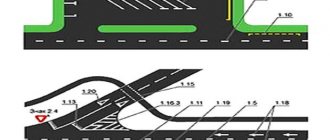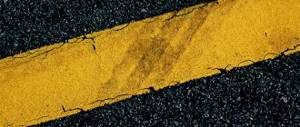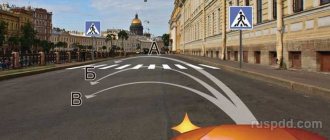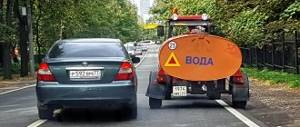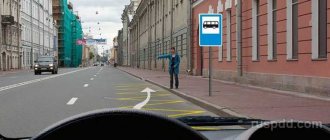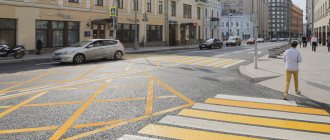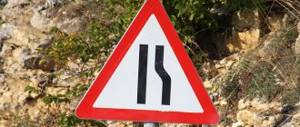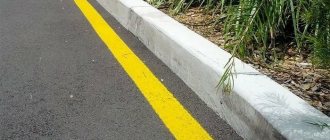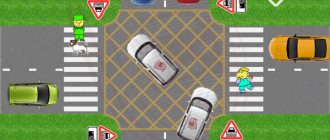In addition to the usual markings that are applied to the roadway, there are vertical markings. From the name it is clear in what spatial position it is located. But why do road workers complicate traffic rules? Are ordinary markings and road signs not enough? It turns out that no. This element of sign instructions in the rules of the road is of a warning nature, designed to attract special attention from the driver. Let's still figure out for what purposes our roads are marked with such unusual markings.
Why do you need vertical markings?
Vertical road marking lines are used to paint road objects in order to inform the driver of approaching danger. As the vehicle moves, it encounters elements of overpasses, overpasses, tunnels and other structures that are located very close to the roadway. If during the day such supports can be seen long before approaching them, then at night they can often be invisible to the human eye.
In order to highlight such structures, this marking is used. Traffic regulations specifically determine the order of designation of all road objects that the driver may encounter along the entire route.
Objects requiring designation.
- Support columns for bridges, overpasses and overpasses.
- Curbs and bollards that enclose traffic islands.
- Side fencing elements of the road.
- Lamp post supports.
- Trees, as well as other elements or parts thereof, which are located closer than one meter from the edge of the roadway.
Each object that is located closer than 1 meter from the roadway must be marked with a special type of vertical marking defined in the traffic rules. Such elements are indicated by painting them with reflective paint. If, due to certain properties of the object, it is impossible to paint it, then a sheet of galvanized metal is painted, or a plastic picture is used.
Vertical markings 2.1.1 - 2.1.3
Vertical marking 2.1 is an alternating black and white shading at an angle of 45 degrees, as in the figure below.
Markings 2.1.1-2.1.3 are used to designate vertical elements (surfaces) of road structures (bridge supports, lighting poles, overpasses, ends of parapets and other obstacles located within the curb) when these elements pose a danger to moving vehicles.
An example of vertical marking 2.1 against the background of road infrastructure is in the picture below (on light poles).
Markings 2.1.1 and 2.1.3 are applied to a structure (obstacle), located respectively to the left or right of the roadway, markings 2.1.2 - if it can be driven around on both sides.
Types of vertical markings
Certain vertical markings of traffic rules are applied to various elements of the road infrastructure. For convenience, existing State Standards, as well as current traffic rules, have adopted a single numbering of symbols.
2.1 – applied to the vertical parts of automotive components. Usually these are support posts of overpasses or bridges, supports of bridge barriers. This designation applies to elements that extend in their parts into a meter zone from the edge of the roadway, or from horizontal road markings. If the designated object is massive, only part of it is painted: 0.5 meters in width and up to 2 meters in height.
This marking has varieties that are determined by indicating the direction to avoid the obstacle. So, right-hand, left-hand, and also a detour on both sides can be indicated.
2.2 – indicates the upper limit of the span. It can be found where the distance from the upper edge of the road to the lower edge of the artificial structure is less than five meters. These can be the lower parts of overpass spans, the upper boundaries of tunnels, as well as other elements that are located directly above the roadway.
The marking element is made in the form of alternating vertical black and white stripes. It is installed above the middle of the traffic lane or a solid line above the entire surface of the roadway.
2.3 – indicated in the form of horizontal alternating white and black stripes. Concrete columns called pedestals are painted with it. These posts are installed at the beginning of the dividing strip, as well as in the area of traffic islands.
Road markings numbered 2.1 – 2.3 are applied directly to the designated element. If the road situation does not allow the installation of lighting devices, then it is applied with a special paint that is reflected in the headlights. If it is impossible to paint the element itself, a pre-painted road sign is attached to it.
2.4 – applied to boundary posts or sign posts. It can also be found on the supports of road fences. It is similar to markup number 2.1. The difference is one oblique stripe on the column. The strip is tilted towards the roadway. This is done to mark the edge of the road.
2.5 – applied to the fence along the road. Such a fence is installed right at the edge of the road surface in especially dangerous places. In this case, the length of the section on which black and white stripes are depicted must be at least 10 meters.
Most often, this designation can be found on small-radius road turns, or in places where there is a steep slope behind an almost non-existent shoulder. It is also present at all bridge crossings. In general, this marking indicates to the driver the places where there is danger behind the road fence.
2.6 – performed as a straight solid line. It is applied in all other cases, except for cases in which marking 2.5 is required.
2.7 - mainly applied to curbs. It marks the boundaries of sidewalks, safety islands and other elements that, due to their design, rise above the roadway. In addition, it is used to designate places where vehicle traffic is allowed strictly in a straight direction, without the possibility of moving to the side of the road. The curb application method, as well as when painting traffic islands, differs.
Road markings
Road markings are designed to regulate the movement of drivers and pedestrians on all roads and also to ensure the uninterrupted operation of road transport communications.
This issue has become especially relevant recently, when the number of vehicles on the roads has increased significantly and it has become necessary to increase the functional durability of markings (this is achieved by using high-quality materials, including paint).
Road markings are a system of lines applied to the road surface and other road elements. There are mainly white and yellow road markings. It can be vertical and horizontal.
Horizontal road markings are applied directly to the roadway and consist of lines, arrows, inscriptions and other symbols. It determines the modes and order of movement. Vertical markings are applied to equipped road elements; they are a combination of black and white stripes and are intended to determine their dimensions (for example, bridges).
Also, road markings can be permanent or temporary.
Permanent road markings have no time limits and are white, sometimes yellow (lines 1.4, 1.10 and 1.17). Temporary markings are applied to road surfaces for a certain time (mainly during repair work) and are orange in color.
Well-executed markings and high-quality road signs significantly increase traffic safety. If it is poorly visible, then road signs take priority. Drivers should be guided by them when driving.
The same rule applies if road signs and markings contradict each other.
The durability of applied road markings is determined by the period for which it meets the requirements of GOST, and the wear of paint road markings does not exceed 50% of its total area. If the pattern of patterns and lines changes, there should be no visible traces of the old markings.
The marking of highways 2.1-2.3, which do not have artificial lighting, must be carried out using retroreflective materials, and guides and fencing devices (markings 2.4-2.6) must have reflective elements. It is necessary to maintain a level of contrast between the markings and the road surface to ensure that they are sufficiently visible to motorists.
The types of retroreflective elements used and their dimensions must comply with GOST R 50970 and GOST R 50971.
The operational load of road markings is determined by the following characteristics:
- Level of road category and its purpose.
- Level of traffic intensity.
- Indicator of the width of the road, number of lanes.
- The purpose and position of the drawings on this section of the road.
- The presence of twists and turns and the quality of the coating.
- Climate characteristics.
There are two methods of applying road markings: paint, which is considered the cheapest, is used when applying road markings for parking lots, courtyard areas, etc.
, and application with plastic, which has a higher guarantee of operation, but at the same time the cost of road markings is higher.
This method of application is used on federal highways, highways, etc.
According to the method of application, plastic is divided into hot and cold.
Cold plastic is mainly used to restore road markings after repairs.
Thermoplastic for road markings is intended for professional application of horizontal road markings on asphalt concrete roads, parking lots, bus stops, pedestrian crossings, etc.
It is applied using special road marking equipment that can melt thermoplastic at a temperature of +180°C.
All of the above products and services offered by our company fully comply with GOST road markings.
Prices for applying road markings
| On-site visit and consultation of a specialist | PC. | For free |
| Solid line longitudinal marking: paint/thermoplastic/cold plastic | m2p. m. | 270/850/140045/85/140 |
| Dotted line longitudinal marking: paint/thermoplastic/cold plastic | m2p.m. | 270/850/140014/85/140 |
| Cross line road markings: paint/thermoplastic/cold plastic | m2p.m. |
Regulatory regulation
Application parameters, as well as the dimensions of vertical marking stripes, are determined by GOST 13508-74. Road markings”, as well as “GOST 23457-86. Technical means of organizing traffic."
These two documents fully describe all the requirements for applying vertical markings to road facilities:
- line thickness;
- tilt angle;
- procedure for use and installation;
- use of reflective paint and elements;
- installation locations, etc.
Traffic rules indicate links to state standards that are valid at the time of their preparation. This makes it possible to avoid ambiguity in understanding the rules, and to ensure strict compliance by all officials with the requirements for handling vertical markings.
Post Views: 14
Horizontal markings along the roadway
Along the roadway, solid or broken lines are drawn, which can be single or double.
Horizontal markings 1.1 indicate the boundaries of lanes into which entry is prohibited; separates traffic flows in opposite directions; marks the boundaries of parking spaces.
1.2.1 (solid line) indicates the edge of the roadway.
1.3 separates opposing traffic flows on roads that have 4 or more lanes.
Crossing solid horizontal lines 1.1, 1.2.1, 1.3 is prohibited. The exception is places where stopping and parking are permitted; You can also cross solid line 1.2.1, which marks the edge of the roadway and is located on the right in the direction of travel.
1.2.2 (dashed line with strokes 2 times shorter than the spaces between them) indicates the edge of the roadway on two-lane roads.
1.5 separates opposing traffic flows on roads with 2 or 3 lanes; indicates the boundaries of traffic lanes when there are 2 or more lanes in one direction.
1.6 (dashed line with a stroke length that is 3 times longer than the spaces between them) warns of approaching markings 1.1 or 1.11.
